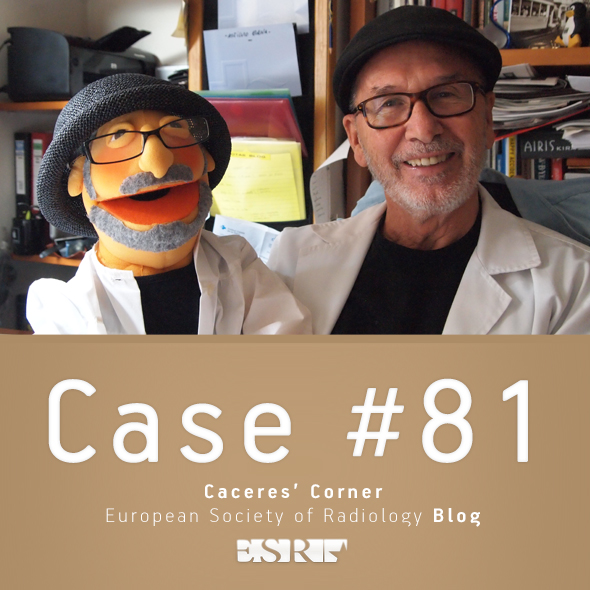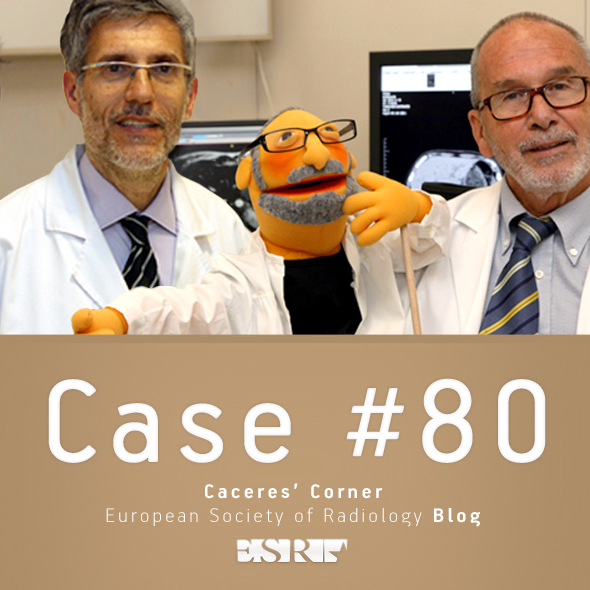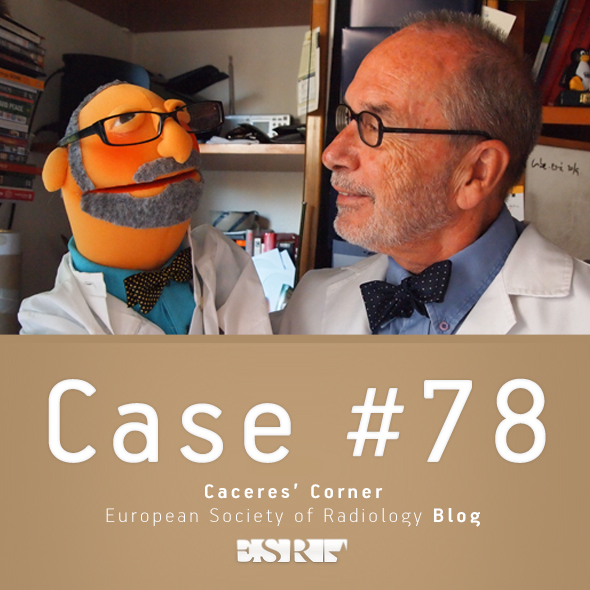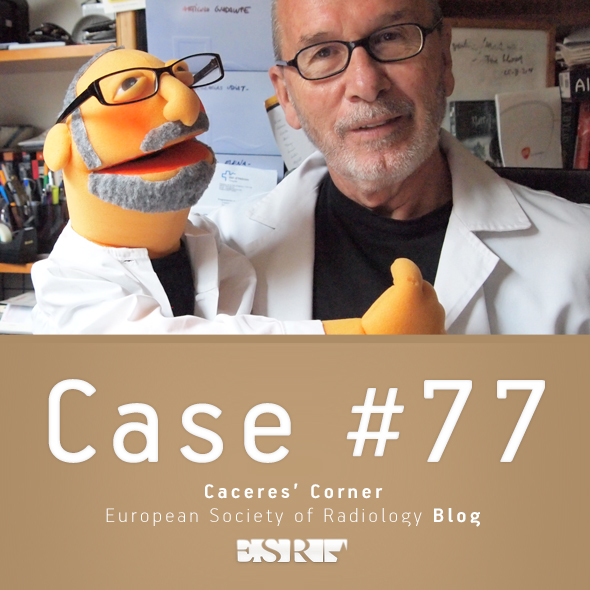
A-254 A. Plain radiography
J. Cáceres | Saturday, March 9, 10:30 – 12:00 / Room A
There are certain signs in the chest radiograph, which help in the identification and differential diagnosis of selected processes. Their appearance is characteristic enough to be identified. Some of them correspond to normal variants, which should not be confused with pathologic processes. In this presentation, we will describe several signs in chest imaging that, in our experience, have proven helpful to us in the diagnosis of chest pathology.

Dear Friends,
Muppet and I just returned from the RSNA meeting in Chicago (Muppet very happy after spending the week with Miss Piggy!). This week we’re presenting a straightforward case to make you happy as well. Images belong to a 63-year-old man with vague chest complaints.
Where is the abnormality and what do you think it is? Leave yout thoughts and diagnosis in the comments section and come back on Friday for the answer.
Read more…

A-451 Coronary artery imaging from a chest CT examination: when and how
R. Marano | Sunday, March 10, 14:00 – 15:30 / Room G/H
The continuous technological evolution of multi-detector CT scanner characterized by larger detector array with increased anatomical coverage per rotation, faster rotation and table speed, and shorter acquisition time have made reliable to perform chest imaging with reduced cardiac motion artifacts, improving the assessment of heart and contiguous structures in the course of routine thorax CT. Further, the larger anatomic coverage of detectors and the availability of scan protocols with lower radiation dose have also made reliable to apply ECG-synchronization to chest CT study, and therefore to couple cardiac/coronary imaging with chest imaging. Different clinical queries requiring a chest CT imaging may underlie cardiac or coronary source that is not clinically evident; similarly, patients scheduled for thoracic surgery, staging or studied in emergency setting may present unexpected heart or coronary artery findings that can be detected in the course of pre-operative CT or may change the treatment and prognosis. Therefore, the capability to perform the assessment of both the heart and chest by a single diagnostic tool is becoming progressively significant because the evaluation of the heart often can provide clinically relevant information in the course of routine or emergency chest CT that is not otherwise easily available.

Dear Friends,
This week I am showing you a case provided by my good friend Dr. Jordi Andreu. The radiographs below belong to a 39-year-old woman with increased shortness of breath for the last three months. Leave your thoughts and diagnosis in the comments section and come back for the answer on Friday.
Diagnosis:
1. Bullous emphysema
2. Tension pneumothorax
3. Adenomatoid malformation
4. None of the above
Read more…

Dear Friends,
Today I am presenting the case of a 52-year-old man who underwent a bilateral lung transplant two years ago. He developed chest pain following bronchoscopy and endobronchial biopsy.
Examine the images below and leave your thoughts in the comments section.
What do you see?
It is significant?
Read more…

Dear Friends,
To compensate for the subtle findings in the previous case, I am presenting an obvious one in a 69-year-old man with chest pain. What would be your diagnosis before CT?
Check the images below and leave your thoughts in the comments section. The answer will be added on Friday.
1. Endothoracic goiter
2. Aortic aneurysm
3. Thymoma
4. None of the above
Read more…

Dear Friends,
Muppet saw this case while looking at daily chest radiographs and it caught his attention. We looked at the patient’s history and found that she was a 64-year-old female with back pain, who had a well-differentiated liposarcoma removed from her right thigh seven years earlier.
Do you see anything?
What do you think it is?
Check the images below and leave your thoughts in the comments section. The answer will be posted on Friday.
Read more…

Dear Friends,
Presenting the case of a 45-year-old man with fever, one week after coronary surgery. I apologise for the poor quality of the PA radiograph, but it does not influence the diagnostic evaluation.
Check the images below and leave your opinion in the comments. The answer will be posted on Friday.
Diagnosis:
1. Pericardial fluid
2. Pleural fluid
3. Both
4. Anything else
Read more…

Dear Friends,
This week I am presenting radiographs of a 78-year-old male with haemoptysis. Have a look at the images below and leave us your thoughts and diagnosis in the comments section. The answer will be added on Friday.
Diagnosis:
1. Hydropneumothorax in minor fissure
2. Tuberculosis
3. Carcinoma
4. None of the above
Read more…

B-0297 Non-solid, part-solid or solid? Classification of pulmonary nodules in thoracic CT by radiologists and a computer-aided diagnosis system
C. Jacobs, E.M. van Rikxoort, J.-M. Kuhnigk, E.T. Scholten, P.A. de Jong, C. Schaefer-Prokop, M. Prokop, B. van Ginneken | Friday, March 8, 10:30 – 12:00 / Room D1
Purpose: Classifying pulmonary nodules into solid, part-solid and non-solid is crucial for patient management. A computer algorithm is compared to a radiologist on a large data set obtained from a multi-center lung cancer screening trial.
Methods and Materials: Low-dose chest CT scans (16×0.75mm, 120-140 kVp, 30 mAs) with part-solid, non-solid, and solid nodules with a diameter between 7 and 30 mm were randomly selected from two sites participating in the Dutch-Belgian NELSON lung cancer screening trial. The set contained 137 scans, including 50 part-solid, 50 non-solid and 52 solid nodules. The nodule-type recorded in the screening database was used as a reference standard. An automated classification system for characterization of nodules was designed using morphometric features. The accuracy of the computer algorithm was evaluated in three ways: classifying nodules (1) as solid or subsolid, (2) as solid, part-solid or non-solid, and, (3) for the subsolid lesions only, as part-solid or non-solid. An experienced thoracic radiologist independently performed the same classification.
Results: The accuracy of the automated system to differentiate between solid and subsolid nodules was 0.88, compared to 0.95 for the radiologist. The computer classified the nodules as solid, part-solid or non-solid with an accuracy of 0.72 versus 0.80 for the radiologist. The software reached an accuracy of 0.71 in differentiating part-solid from non-solid nodules, where the radiologist had an accuracy of 0.77.
Conclusion: A novel automated characterization tool for pulmonary nodules shows promising performance and could aid radiologists in selecting the appropriate workup for pulmonary nodules.









